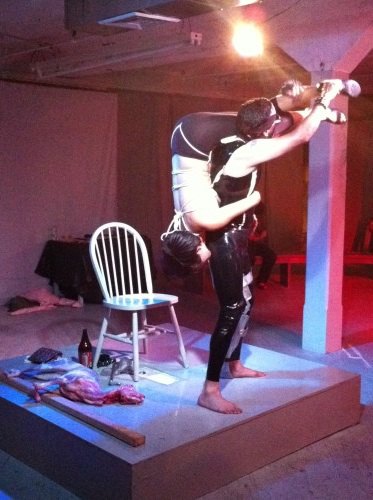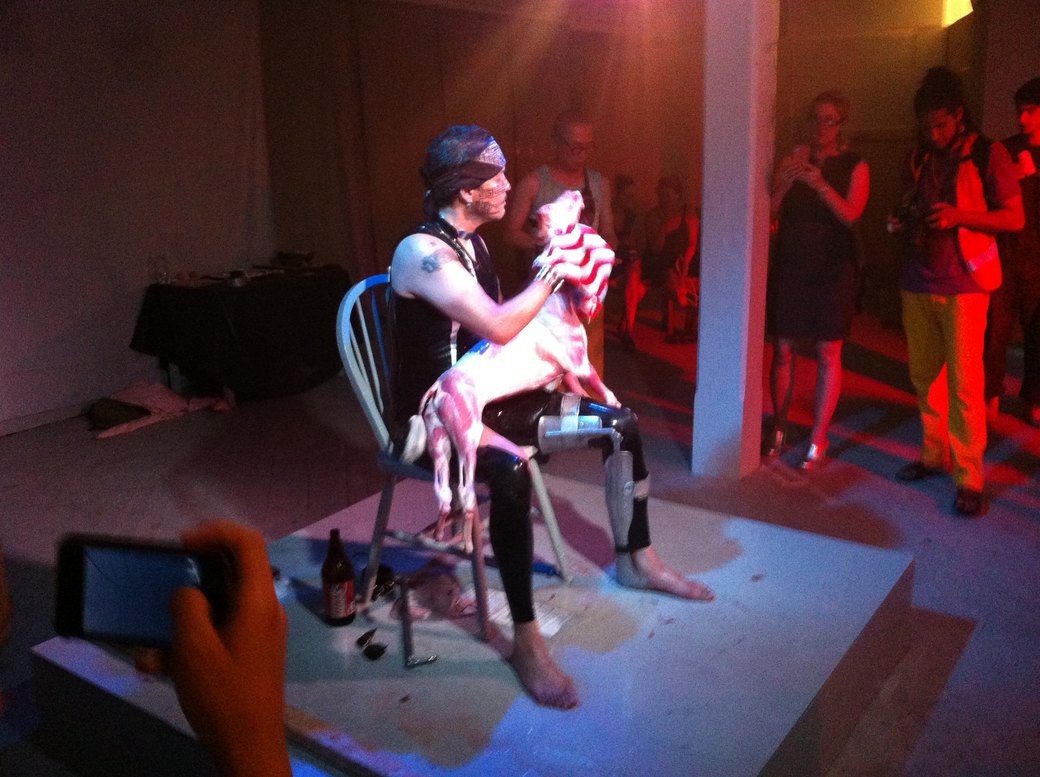
This past Friday night, Grace Exhibition Space welcomed La Pocha Nostra to Bushwick, bringing their post-national, apocalyptic, trans-cultural performance with them. Dressed in a hybrid costume of clichéd Indian/cowboy, Guillermo Gómez-Peña, artist and director of La Pocha Nostra, introduced the night’s performances, speaking broadly of the context for the upcoming show. “The world [is] collapsing all around us,” intoned Gómez-Peña. His monologue, perfectly bilingual, waxed poetically about the state of the world, racial politics, globalization, and even performance art itself, seeing the art as a “failed attempt to find the truth.” While outwardly this diatribe seemed woeful, just as the simultaneous performances too felt heavy, dark and at times hopeless, the entire theme of the night dealt with issues of spirituality and sacrifice, cleansing, and honestly exposing oneself with a willingness to fall in order to rise up again.

La Pocha Nostra loosely means “cartel of the cultural traitors,” and stems from a term used to describe Mexicans who transgress their national border, conflated with the name for the Italian mafia, La Cosa Nostra. This concept of treachery, impurity and banding together creates an entire culture around Gómez-Peña’s performance art troupe, where individual artists unite in their own disparate, personal performances to elucidate a larger significance and even more interactive and dynamic performance art experience. While the group’s origins rest with Gómez-Peña’s own Mexican identity and the head-on confrontation of border politics and cultural stereotypes, today’s La Pocha Nostra is comprised of several core members with various cultural backgrounds where identity is only one of the significant themes they address.
When I arrived at Grace on Friday night, the space buzzed with excitement, and I got there just in time for the beginning of the performance. Set up as four “living dioramas,” each of the core artists of the troupe stood waiting for Gómez-Peña to activate the space with his words. As we listened to Gómez-Peña, dressed as a self-proclaimed “aging deviant shaman,” the space itself took on a life of its own. Moving clockwise around the space, we immediately became intimately familiar with a Chula Libre fighter with a machete and mechanical tail (Erica Mott), a neo-Aztec priest and his skinned goat (Roberto Sifuentes), a trained acupuncturist performing global capitalist treatment on a patient, and a sex-crazed drag-queen humping everything in sight. The constant movement, character changes, and dead animals cum props, left my head spinning a little, which in essence is the aim of the event. Not for the faint of heart, La Pocha Nostra’s performances are meant to push you out of your comfort zone, make you angry or squeamish or even frightened. Just when you fear you might spin out of control, Gómez-Peña emerges to center, instruct and urge you to go a little bit deeper down the rabbit hole.
Each constructed performance utilized clear metaphor, at some moments more obviously than others, in order to deconstruct the codes of identity. While acting as individuals, the artists together presented a mess of stereotypes, global scenarios, and historical reinterpretation, pushing the audience to see, to interact and to become a part of what they usually do not wish to recognize or confront. Drawing “volunteers” from the audience, a gas pump-toting flamenco dancer (Mott), marked an audience member with a lipstick target, urging others to kiss the target, violently. More spiritually and somberly, at one point in the night Sifuentes, with assistance from another Pocha Nostra member, tied his skinned goat to his shoulders, while a candle-laden wooden beam was strewn between his arms, and his face was bound with cord. Hardly moving and clearly beginning to struggle with his binding, members of the audience spontaneously began to approach him one by one, to extinguish the candles thereby easing some of his burden. Similarly, Gómez-Peña called upon the audience to assist in the removal of acupuncture needles to the capitalist patient, that released her from global-corporate bondage.

The culmination of the night’s event came when Gómez-Peña himself stepped onto the stage with a toy machine gun. Again drawing willing participants from the crowd, Gómez-Peña goaded these volunteers to take the gun and pose with him, pointing the gun directly at his heart, head, or anus, as ever he saw fitting. The entire evening can be characterized as incredibly cohesive, as the performers seamlessly interacted with one another, creating rich tableaux vivants of their characters, nothing rushed, nothing forced. While Gómez-Peña’s troupe is a fully emerged group, they have not become stagnant and are still very much à propos in today’s world. Without becoming trite or clichéd, the night’s performance deeply engaged its audience, pushed us to question our own current age of media proliferation, corporation-citizens, and what the “we” of America is today. As the night came to an end, I was left with the image of Gómez-Peña imprinted on my brain, as he walked around the room, pointing out key moments in a performance, simply proclaiming, “That’s a good image.”
Friday’s event at Grace Exhibition Space was part of the Brooklyn International Performance Art Festival. Taking place across 11 spaces in Brooklyn and involving over 150 artists from all over the world, BIPAF is posited as a form of “constructive institutional critique” by its artist-organizers, as demonstration against the increasing capitallization of performance art, as a self-analysis of the current performance art resurgence and index of the discipline, and as an attempt to relationally construct new economic and social contexts for performance art.


